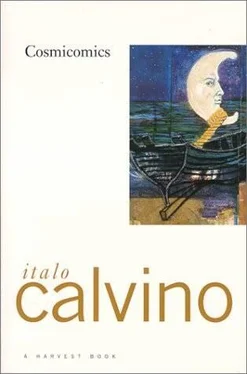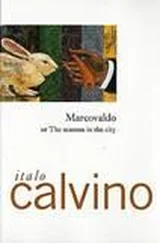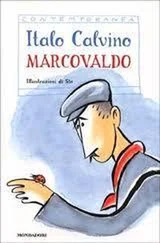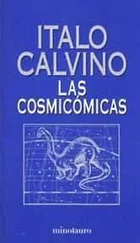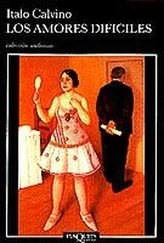And the more I torment myself with love for each of them, the less I can bring myself to say to them: "Here I am!," afraid of being mistaken and even more afraid that she is mistaken, taking me for somebody else, for somebody who, for all she knows of me, might easily take my place, for example the beach-boy with the gold chain, or the director of the observatory, or a gull, or a male anchovy, or the reader of Herodotus or Herodotus himself, or the vendor of ice cream, who has come down to the beach along a dusty road among the prickly pears and is now surrounded by the Dutch girls in their bathing suits, or Spinoza, or the truck driver who is transporting the life and works of Spinoza summarized and repeated two thousand times, or one of the drones dying at the bottom of the hive after having fulfilled his role in the continuation of the species.)
…Which doesn't mean that the shell wasn't, first and foremost, a shell, with its particular form, which couldn't be any different because it was the very form I had given it, the only one I could or would give it. Since the shell had a form, the form of the world was also changed, in the sense that now it included the form of the world as it had been without a shell plus the form of the shell.
And that had great consequences: because the waving vibrations of light, striking bodies, produce particular effects from them, color first of all, namely, that matter I used to make stripes with which vibrated in a different way from the rest; but there was also the fact that a volume enters into a special relationship of volumes with other volumes, all phenomena I couldn't be aware of, though they existed.
The shell in this way was able to create visual images of shells, which are things very similar – as far as we know – to the shell itself, except that the shell is here, whereas the images of it are formed elsewhere, possibly on a retina. An image therefore presupposes a retina, which in turn presupposes a complex system stemming from an encephalon. So, in producing the shell, I also produced its image – not one, of course, but many, because with one shell you can make as many shell-images as you want – but only potential images because to form an image you need all the requisites I mentioned before: an encephalon with its optic ganglia, and an optic nerve to carry the vibrations from outside to inside, and this optic nerve, at the other extremity, ends in something made purposely to see what there is outside, namely the eye. Now it's ridiculous to think that, having an encephalon, one would simply drop a nerve like a fishing line cast into the darkness; until the eyes crop up, one can't know whether there is something to be seen outside or not. For myself, I had none of this equipment, so I was the least authorized to speak of it; however, I had conceived an idea of my own, namely that the important thing was to form some visual images, and the eyes would come later in consequence. So I concentrated on making the part of me that was outside (and even the ulterior part of me that conditioned the exterior) give rise to an image, or rather to what would later be called a lovely image (when compared to other images considered less lovely, or rather ugly, or simply revoltingly hideous).
When a body succeeds in emitting or in reflecting luminous vibrations in a distinct and recognizable order – I thought – what does it do with these vibrations? Put them in its pocket? No, it releases them on the first passer-by. And how will the latter behave in the face of vibrations he can't utilize and which, taken in this way, might even be annoying? Hide his head in a hole? No, he'll thrust it out in that direction until the point most exposed to the optic vibrations becomes sensitized and develops the mechanism for exploiting them in the form of images. In short, I conceived of the eye-encephalon link as a kind of tunnel dug from the outside by the force of what was ready to become image, rather than from within by the intention of picking up any old image.
And I wasn't mistaken: even today I'm sure that the project – in its over-all aspect – was right. But my error lay in thinking that sight would also come to us, that is to me and to her. I elaborated a harmonious, colored image of myself to enter her visual receptivity, to occupy its center, to settle there, so that she could utilize me constantly, in dreaming and in memory, with thought as well as with sight. And I felt at the same time she was radiating an image of herself so perfect that it would impose itself on my foggy, backward senses, developing in me an interior visual field where it would blaze forth definitely.
So our efforts led us to become those perfect objects of a sense whose nature nobody quite knew yet, and which later became perfect precisely through the perfection of its object, which was, in fact, us. I'm talking about sight, the eyes; only I had failed to foresee one thing: the eyes that finally opened to see us didn't belong to us but to others.
Shapeless, colorless beings, sacks of guts stuck together carelessly, peopled the world all around us, without giving the slightest thought to what they should make of themselves, to how to express themselves and identify themselves in a stable, complete form, such as to enrich the visual possibilities of whoever saw them. They came and went, sank a while, then emerged, in that space between air and water and rock, wandering about absently; and we in the meanwhile, she and I and all those intent on squeezing out a form of ourselves, were there slaving away at our dark task. Thanks to us, that badly defined space became a visual field; and who reaped the benefit? These intruders, who had never before given a thought to the possibility of eyesight (ugly as they were, they wouldn't have gained a thing by seeing one another), these creatures who had always turned a deaf ear to the vocation of form. While we were bent over, doing the hardest part of the job, that is, creating something to be seen, they were quietly taking on the easiest part: adapting their lazy, embryonic receptive organs to what there was to receive; our images. And they needn't try telling me now that their job was toilsome too: from that gluey mess that filled their heads anything could have come out, and a photosensitive mechanism doesn't take all that much trouble to put together. But when it comes to perfecting it, that's another story! How can you, if you don't have visible objects to see, gaudy ones even, the kind that impose themselves on the eyesight? To sum it up in a few words: they developed eyes at our expense.
So sight, our sight, which we were obscurely waiting for, was the sight that the others had of us. In one way or another, the great revolution had taken place: all of a sudden, around us, eyes were opening, and corneas and irises and pupils: the swollen, colorless eye of polyps and cuttlefish, the dazed and gelatinous eyes of bream and mullet, the protruding and peduncled eyes of crayfish and lobsters, the bulging and faceted eyes of flies and ants. A seal now comes forward, black and shiny, winking little eyes like pinheads. A snail extends ball-like eyes at the end of long antennae. The inexpressive eyes of the gull examine the surface of the water. Beyond a glass mask the frowning eyes of an underwater fisherman explore the depths. Through the lens of a spyglass a sea captain's eyes and the eyes of a woman bathing converge on my shell, then look at each other, forgetting me. Framed by far-sighted lenses I feel on me the far-sighted eyes of a zoologist, trying to frame me in the eye of a Rolleiflex. At that moment a school of tiny anchovies, barely born, passes before me, so tiny that in each little white fish it seems there is room only for the eye's black dot, and it is a kind of eye-dust that crosses the sea.
Читать дальше
